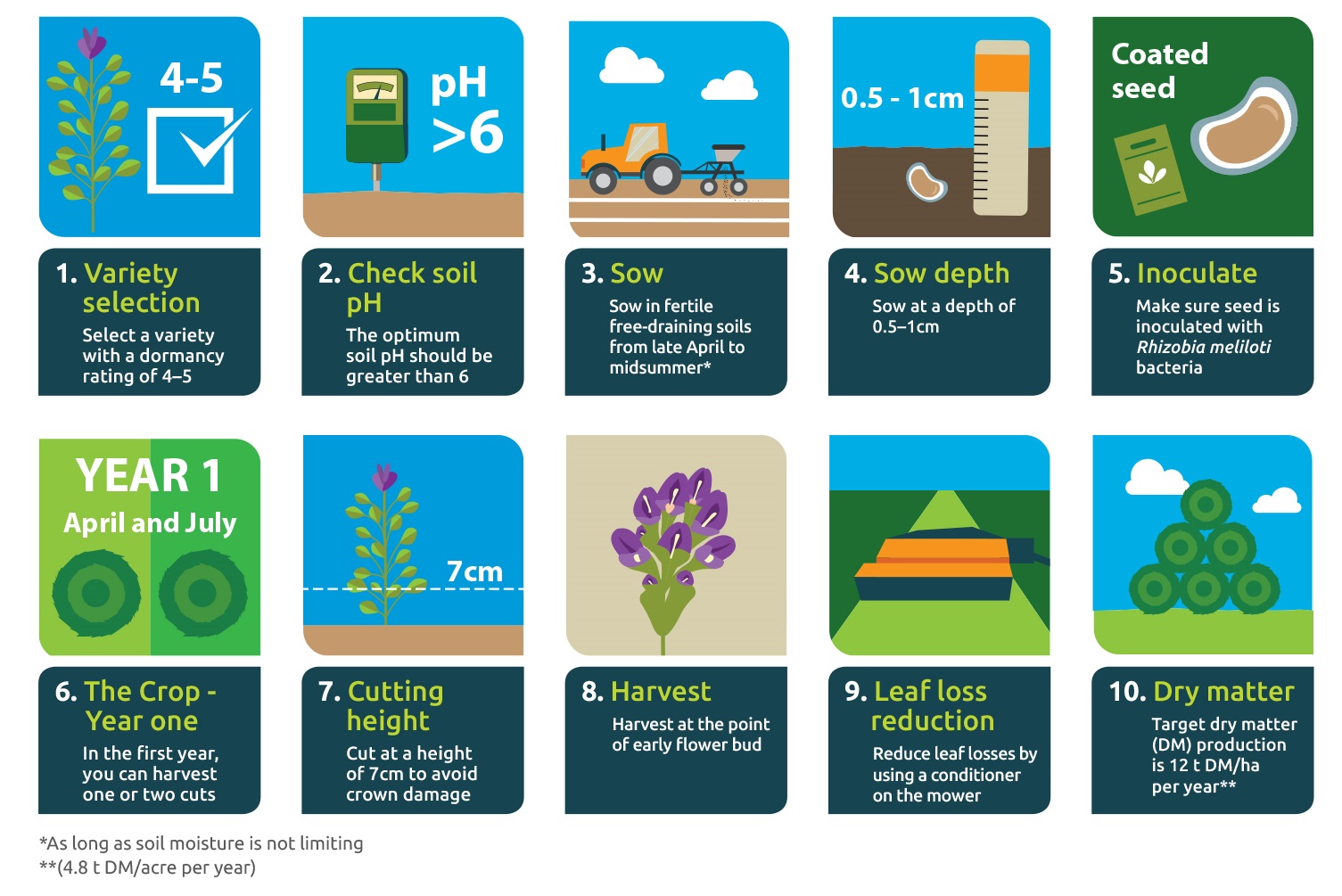- Home
- Knowledge library
- Growing and feeding lucerne
Growing and feeding lucerne

Growing and feeding lucerne
Welcome to the Growing and feeding lucerne series. This series will help you to decide whether lucerne is suitable for your farm. It also gives advice about how to grow it, including topics such as establishment costs and choosing suitable fields.
Lucerne, commonly known as alfalfa, is valued for its yield, protein content, digestible fibre and drought tolerance.
Like other legumes, such as clover, peas and beans, it does not grow when the soil temperature is below 8°C, so in the UK does well between April/May and September. Yields can struggle in a cold spring and – even with its drought tolerance – in dry summers.
Ten top tips on growing lucerne

Lucerne is not suitable for every system – there are pros and cons to consider.
| Pros | Cons |
|---|---|
|
High yielding (12 t DM/ha per year) |
Needs multiple cuts (3–4 per year) |
|
High protein (18–22% crude protein, CP) |
Low energy levels (10 MJ of metabolisable energy, ME) |
|
No requirement for applied nitrogen (N) |
Moderate requirement for phosphate, sulphur and magnesium and high requirement for potash and calcium |
|
Once the crop is established, it can suppress weeds |
Slow establishment, which means weeds can dominate |
|
Forage rich in digestible fibre |
Can cause bloat in grazing animals |
|
High levels of minerals and vitamins |
Has a requirement for boron, molybdenum and manganese |
|
Contains high quality amino acids (similar to those in milk) |
– |
Case study: Ben Dixon, dairy and beef farmer, Shropshire
We have 70 organic Jersey cows, milked through a robot. We aim to feed lucerne all-year-round through silage or strip or zero grazing. If grazing, they tend to do better if the crop is younger.
Our oldest stand is five years old and is still doing well. We tend to establish it in the spring with spring barley, which will take off as a wholecrop silage and then have a light grazing in the first autumn.
We apply some slurry in the spring, but limited other inputs.
When we make silage, we cut it in the afternoon and then move it into six-metre (20 ft.) swathes. It is picked up 24–48 hours later and clamped. There is around five to six weeks between cuts.
We have found that it can struggle in dry times, but does better than red clover. We have a dry farm and in the dry summer a few years ago, we lost fields of red clover but the lucerne came back.
The cost of growing lucerne
Example costings for growing lucerne, based on 2018 figures.
|
Establishment |
2018 (£/ha) |
|
Seed and inoculation (20 kg @ £7.50/kg) |
150 |
|
Fertiliser – 60 kg phosphate and 60 kg potash per hectare (possibly N in low N soils, e.g. after cereals) |
68 |
|
Crop protection |
60 |
|
|
278 |
|
Establishment variable costs |
|
|
Ploughing |
61 |
|
Discing |
59 |
|
Power harrowing |
52 |
|
Flat rolling |
30 |
|
Drilling (seed and fertiliser) |
50 |
|
Establishment contractor cost |
252 |
|
Total establishment cost per crop per year (over 5 years) |
106 |
|
|
|
|
Annual costs |
£/ha |
|
Complete harvest (at 3.5 cuts per year at £145/ha/cut) |
508 |
|
Fertiliser spreading |
12 |
|
Annual fertiliser (0N:120 kg phosphate:220 kg potash) |
182 |
|
Establishment costs (from above) |
106 |
|
Land rental |
186 |
|
Total annual cost |
994 |
|
Example costs |
£/ha |
|
Cost/kg DM (at 12 t DM/ha production) |
0.08 |
|
Cost/kg DM (at 12 t DM/ha production) without land rental charge |
0.07 |
|
Cost/kg protein (at 12 t DM/ha production at 21% protein) |
0.39 |
|
Cost/kg protein as above without land rental charge |
0.32 |
The information in these web pages was compiled by Dr Liz Genever, Independent beef and sheep consultant and Dr Debbie McConnell, Agri-Food and Biosciences Institute.
Topics:
Sectors:
Tags:


